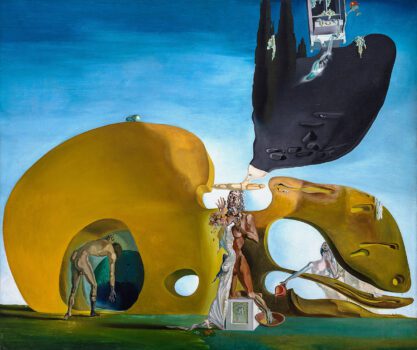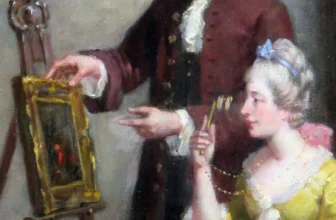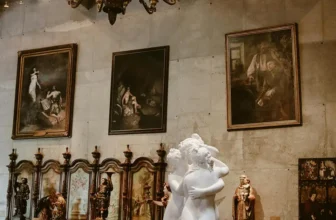Meaning of The Birth of Liquid Desires Painting by Salvador Dalí
Salvador Dalí’s 1932 surrealist masterpiece, The Birth of Liquid Desires, is a complex and evocative painting that occupies a significant place within his early surrealist period. Known for his dream-like visuals and psychoanalytic symbolism, Dalí challenges the viewer with an enigmatic scene populated by amorphous forms, ambiguous human figures, and metaphoric elements that collectively seem to resist straightforward interpretation. This painting is both a deeply personal and a profoundly philosophical work, one that grapples with questions of identity, pleasure, family trauma, and subconscious desire. In this article, we will explore the intricate symbolism of The Birth of Liquid Desires, the process behind its creation, the psychological and cultural themes it explores, and its lasting impact as a surrealist icon.
Salvador Dalí painted The Birth of Liquid Desires in 1932, during a period of intense collaboration with the Surrealist movement, which was then flourishing in Paris under the influence of André Breton. Dalí had joined the Surrealist group only a few years earlier, and by the early 1930s, he had become one of its most prominent figures. His idiosyncratic use of Freudian imagery, dream logic, and hyperrealistic technique helped define the visual language of surrealism.
This particular painting is notable for its emphasis on transformation, desire, and psychological fragmentation. It was created during Dalí’s so-called “paranoiac-critical period,” in which he developed a method of accessing subconscious imagery through a controlled form of self-induced paranoia. This method was designed to destabilize the viewer’s rational understanding and open the door to deeper psychic truths. The painting also reflects Dalí’s own inner conflicts, particularly his strained relationship with his father and the conflicting emotions regarding his mother, who had died when Dalí was just sixteen years old.
Description of the Painting
The Birth of Liquid Desires is a large oil-on-canvas painting measuring approximately 38 x 45 inches (97 x 114 cm). The painting is currently housed in the Guggenheim Museum in New York.
The composition is set in an open, dreamlike landscape, a kind of barren desertscape that serves as a psychological stage rather than a physical location. In the center of the painting is a strange architectural structure resembling a decaying temple or perhaps a distorted womb. Emerging from or within this form is a chaotic scene that includes a reclining hermaphroditic figure, liquid-like shapes, dripping substances, and fragmented body parts such as a leg or buttocks.
To the left of the central mass is a veiled female figure, and above this are surrealistic draperies, recalling Renaissance iconography. To the right, one sees a lion-headed monster suckling from the hermaphroditic figure, suggesting themes of nurturing, consumption, or primal instinct. A small, crouching figure in the lower part of the canvas appears tormented or introspective, possibly representing the artist himself.
The forms melt, bleed, or transform into other entities in a typical Dalinian fashion. The entire work seems suspended in a paradoxical state between creation and disintegration, purity and corruption, flesh and architecture.
Technique and Style
Dalí’s technique in The Birth of Liquid Desires exemplifies the precision and clarity characteristic of the Old Masters, especially influenced by Renaissance and Baroque painters such as Velázquez and Vermeer. His use of meticulous brushwork creates a stark contrast with the bizarre, hallucinatory subject matter.
The palette is muted, earthy ochres, yellows, and soft grays dominate the scene, adding to the sense of timeless decay and interiority. Despite the melting forms and dream-like imagery, the painting retains a photographic sharpness, which enhances the surreal tension between the real and the imaginary.
This contrast between form and content was key to Dalí’s surrealism. He aimed to depict irrational, subconscious visions with the precision of classical realism, thereby destabilizing both traditional painting and rational thought itself. The Birth of Liquid Desires is a textbook example of this approach.
Symbolism and Interpretation
1. The Hermaphroditic Central Figure:
One of the most discussed elements of the painting is the reclining, androgynous central figure, often interpreted as a symbol of Dalí’s ambivalence toward personal pleasure, gender roles, and maternal desire. This figure might also represent a composite of both of his parents, his father and his deceased mother, symbolizing the union or conflict between masculine authority and feminine loss.
The fact that this figure is both nurturing and being consumed reflects the complexity of Dalí’s views on plesure and desire. The lion-headed creature suckling at the hermaphroditic figure may represent a primal, violent form of love or need, perhaps his view of intense passion as both tender and predatory.
2. The Liquid Motif:
The title itself, The Birth of Liquid Desires, invokes transformation, dissolution, and the formless. Liquids in Dalí’s work often symbolize fluidity in identity, thought, and emotion. Here, “liquid desires” may refer to repressed pleasure urges or unspoken fantasies, made manifest in a surreal psychic landscape. The melting, oozing forms challenge the viewer’s sense of bodily integrity and psychological stability.
3. The Veiled Figure:
To the left of the central structure is a veiled woman, often seen as the Virgin Mary or a maternal archetype. However, in Dalí’s world, such figures are never purely sacred, they are filtered through his own psychological experiences. This veiled woman could represent the lost mother or the unobtainable feminine ideal, hidden and inaccessible.
4. The Crouching Male Figure:
A small male figure appears to cower or introspect, drawing a connection with Dalí’s frequent self-portrayals as a troubled and fragmented ego. This figure, isolated and dark, may reflect guilt, anxiety, or a fear of desire failure or inadequacy.
5. Architectural Forms:
The fragmented architectural mass in the center of the painting resembles a surreal temple or monument. This could symbolize the breakdown of rational structures, the “architecture” of the psyche, under the pressure of unconscious drives. It could also allude to the disintegration of familial and cultural foundations, echoing Dalí’s rebellion against patriarchal authority.
Psychological and Freudian Influences
Dalí was profoundly influenced by Sigmund Freud, whose writings on dream interpretation, the Oedipus complex, and repression offered the young painter a vocabulary for exploring his internal chaos. Freud’s theories emphasized the role of childhood trauma, ambiguity, and repressed desire, all themes that Dalí explored throughout his oeuvre.
In The Birth of Liquid Desires, we see an explicit working out of these Freudian tensions. The hermaphroditic figure, the veiled maternal presence, and the infantile monster suggest a family drama played out in symbolic form. Dalí’s own autobiographical writings indicate that he saw a desire development as a terrifying and disruptive process, one marked by fear of impotence, obsession with purity and contamination, and a yearning for maternal reunion.
Artistic Significance and Type
The Birth of Liquid Desires is quintessentially surrealist, yet it defies easy categorization. It merges:
Psychological Realism: By presenting the inner psyche with visual precision.
Metaphysical Allegory: Offering a meditation on identity, birth, and transformation.
Symbolist Tradition: Drawing on a visual language of symbols, masks, and mythical forms.
Proto-Psychoanalytic Art: Anticipating later explorations of trauma, fragmentation, and the unconscious.
This painting also marks a turning point in Dalí’s development. While earlier works leaned toward Cubism and Impressionism, by 1932 he had fully adopted the surrealist idiom. This work demonstrates his mastery of surrealist technique and his commitment to making the subconscious visible.
What Is Happening in the Painting?
On a narrative level, the painting evokes a process, a birth, a transformation, or perhaps a psychological regression. The central figure may be giving birth to “liquid desires,” or being devoured by them. The veiled woman may be mourning, or watching, or representing purity contrasted against the chaos of lust and fantasy. The lion-headed creature may be both infant and predator. These roles are fluid, just like the painting’s forms.
The painting becomes a visual metaphor for the turmoil of human emotion, the complexity of pleasure, and the destabilization of meaning itself. There is no fixed “what is happening”, and that is precisely the point. Dalí believed that understanding should not be linear; it should emerge from confrontation with the irrational.
Where Is The Birth of Liquid Desires Painting Today?
The Birth of Liquid Desires is currently located at the Guggenheim Museum in New York City. It is part of the museum’s Thannhauser Collection, which includes key works of modern art. The painting is often displayed in exhibitions focused on surrealism, psychology, or early 20th-century art. Visitors can view the painting in person and experience its scale, texture, and intensity in a way that reproductions cannot capture.
Over 90 years after its creation, The Birth of Liquid Desires remains one of Dalí’s most studied and enigmatic works. It has influenced generations of artists, psychologists, and theorists who see in it a window into the chaos of the human mind. Its radical reimagining of gender, identity, and familial trauma places it alongside other modernist masterpieces that dared to explore the taboo and the unspeakable.
In popular culture, Dalí’s work continues to inspire filmmakers, fashion designers, and digital artists. The painting’s blend of horror and beauty, decay and birth, still resonates in a world that is ever more fragmented and psychologically complex.
The Birth of Liquid Desires is psychological landscape, a symbolic drama, and a philosophical inquiry. Through its surreal imagery, masterful technique, and disturbing vision, it invites us to confront the desires and fears that lie beneath the surface of consciousness. It is a work that cannot be easily understood, and that is its enduring power. Salvador Dalí, ever the provocateur and visionary, offered in this painting a mirror to our most liquid, mutable, and unsettling desires, and dared us to look. image/ guggenheim




